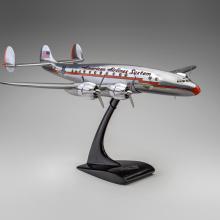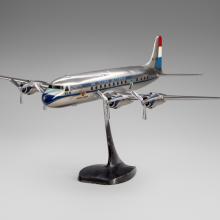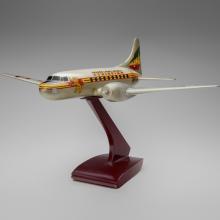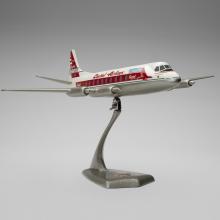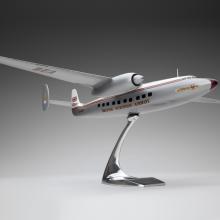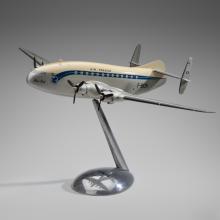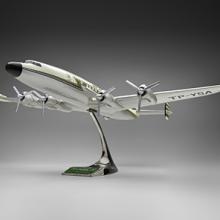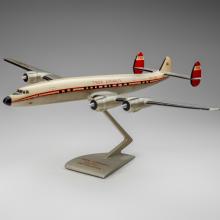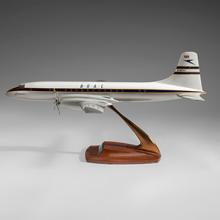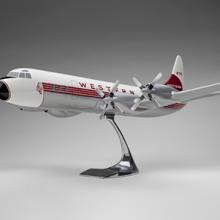International Terminal










American Overseas Airlines Lockheed L-049 Constellation model aircraft c. 1946
Lockheed Aircraft Company, Burbank, California
Scale 1:44
metal, paint
Collection of Anthony J. Lawler
L2011.1001.001
In 1945, in an effort to gain transatlantic routes to Europe, American Airlines purchased American Export Airlines (founded in 1937 as a subsidiary of the shipping company American Export Lines) and renamed it American Overseas Airlines (AOA). The airline then began purchasing suitable aircraft for its new subsidiary. The best choice for the lengthy route to Europe was the Lockheed Model 047 Constellation, one the longest-range and fastest airliners produced at the time. Like other airliner manufacturers, Lockheed had its own in-house model factory that constructed highly-accurately scaled models for its customers. It produced this 1:44 scale model for AOA in polished sheet aluminum and painted in the airline’s earliest livery scheme.
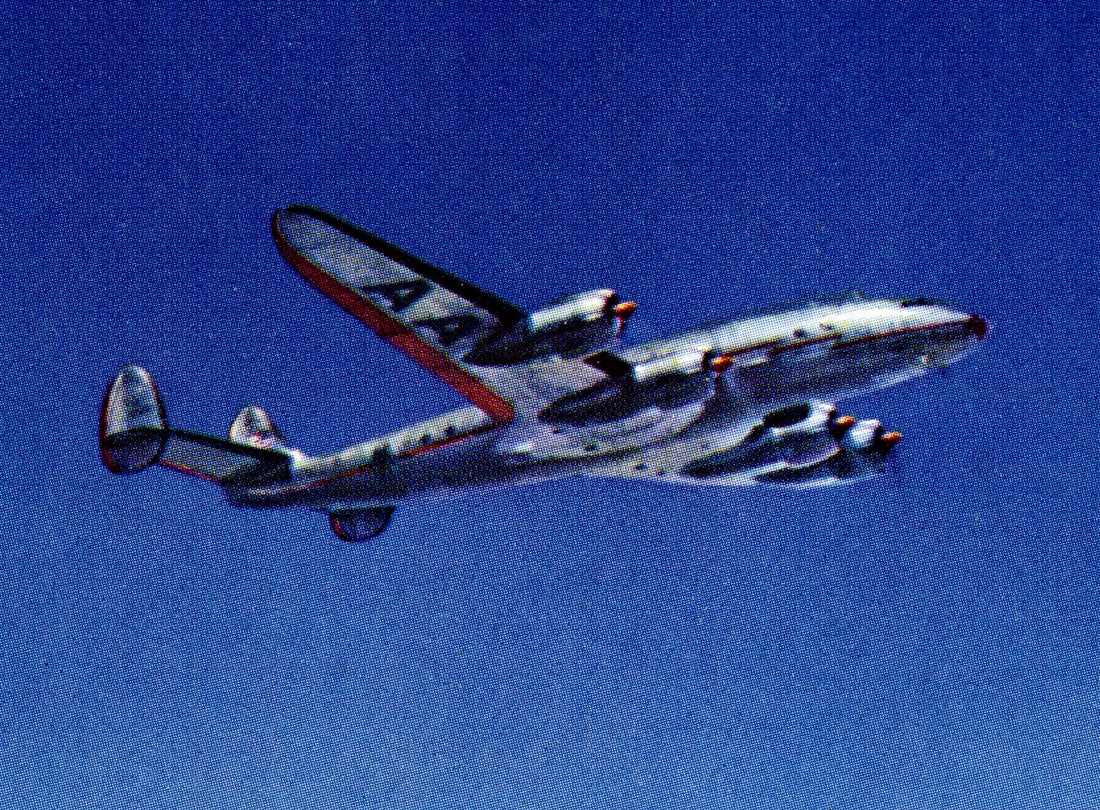 [Inset Image]
[Inset Image]
American Overseas Airlines Lockheed L-049 Constellation postcard c. 1946
paper, ink
SFO Museum
2011.119.001
R2011.1002.012
KLM (Koninklijke Luchtvaart Maatschappij) Royal Dutch Airlines Douglas DC-6 model aircraft c. 1950
Maarten Matthys Verkuyl (Dutch)
scale 1:48
metal, paint
Collection of Anthony J. Lawler
L2011.1001.005
KLM (Koninklijke Luchtvaart Maatschappij) Royal Dutch Airlines commenced service in 1920. After ceasing operations during World War II, the airline rapidly emerged to become a leading European and international carrier during the postwar era. KLM received its first deliveries of the Douglas DC-6, both freighter and passenger versions, in 1948. The DC-6 was the first American-produced airliner to be introduced after the war. The model represents the DC-6 Princess Juliana (Koningin Juliana), which was the second aircraft Douglas delivered of the passenger version. The Dutch model maker Maarten Matthys Verkuyl fabricated the model from sheet zinc for a KLM pilot around 1950. It is one of only two produced by Verkuyl of the type using this material during this period.
 [Inset Image]
[Inset Image]
KLM (Koninklijke Luchtvaart Maatschappij) Royal Dutch Airlines Douglas DC-6 postcard c. 1950
paper, ink
R2011.1001.042
Ethiopian Air Lines Convair 240 model aircraft early 1950s
Peter V. Nelson, Reading, England
scale 1:48
metal, paint
Collection of Anthony J. Lawler
L2011.1001.008
Ethiopian Air Lines was founded in 1946 and began operating out of Addis Ababa Airport in 1947, with administrative, managerial, and flight crew support from TWA (Transcontinental & Western Airlines). In 1950, the airline acquired three Convair 240s in order to expand its routes and offer international service to Europe and Asia. These aircraft were produced by Convair of San Diego, California and developed to replace the Douglas DC-3. The sand-casted metal model represents the first aircraft to be delivered, ET-T-20, and was crafted by Peter V. Nelson in Great Britain during the same period. It was accurately painted in Ethiopian Air Lines’ vibrant early livery with the national colors of red, yellow, and green, and the Lion of Judah, the symbol of Ethiopia’s former ruler Haile Selassie—whose family traces their origins to King Solomon. Selassie played a major role in establishing the national airline, which was considered vital to the modernization of Ethiopia after World War II.
 [Inset Image]
[Inset Image]
Ethiopian Air Lines Convair 240 postcard early 1950s
paper, ink
R2011.1001.034
Capital Airlines Vickers Viscount model aircraft 1950s
Walkers Westway Models, London, England
scale 1:48
metal, paint
Collection of Anthony J. Lawler
L2011.1001.011
Capital Airlines originated out of a merger between Pennsylvania and Central Airlines to form Pennsylvania Central Airlines or PCA in 1936. In 1941, the airline moved its headquarters to the newly built Washington National Airport, and in 1948, changed its name to Capital Airlines. In 1955, in an effort to attract more passengers by offering technologically advanced aircraft, it became the first U.S. carrier to inaugurate turboprop-powered airliner service with the introduction of the British produced Vickers Viscount. The aircraft was originally introduced by BEA (British European Airways) in 1950, which made it the first of its kind to go into service, and moreover, it was years ahead of the introduction of other turboprop airliners. Capital purchased sixty of the aircraft and realized an increased market share nearly everywhere the Viscount flew. This sand-cast metal model was produced in the 1950s by Walkers Westway in London, England, and accurately painted in Capital’s iconic 1950s red, white, and blue livery with eagle logo.
 [Inset Image]
[Inset Image]
Capital Airlines Vickers Viscount model aircraft postcard 1950s
paper, ink
R2011.1001.039
BEA Airspeed AS.57 Ambassador model aircraft 1950s
Shawcraft Models, Uxbridge, England
scale 1:48
wood, metal, paint
Collection of Anthony J. Lawler
L2011.1001.012
In 1946, BEA (British European Airways) was formed as the British flag carrier for domestic and Continental Europe flights. By 1947, a number of independent airlines, including Scottish Airways, had merged with the company. In 1948, BEA placed an order for twenty of the Ambassador, a Douglas DC-3 replacement that had been under development by Airspeed of Great Britain since the latter years of World War II. This high-wing, tripletail, two-engine, mid-range aircraft was introduced in 1952 and operated by the airline until 1958. Shawcraft of Great Britain crafted the model of wood during the same decade, which accurately represents the Ambassador RMA Elizabethan, the flagship of the fleet. BEA’s comfortable Ambassador service, which was named “Elizabethan Class,” became highly popular among commuters between Britain and the Continent.
 [Inset Image]
[Inset Image]
BEA Airspeed AS.57 Ambassador postcard 1950s
paper, ink
R2011.1001.043
Air France Breguet 763 Provence model aircraft 1950s
La Maquette d'Etude et d'Exposition Г Aubervilliers, France
scale 1:50
wood, plastic, metal, paint
Collection of Anthony J. Lawler
L2011.1001.014
Created in 1933 through a merger of several French aviation concerns, Air France became one of the largest airlines in Europe by the late 1930s, with routes throughout Europe and to French colonies in North Africa and Asia. During World War II, the carrier moved its base of operation to Morocco, and by 1946, became nationalized by the French government and opened its first terminal in central Paris. During the latter years of the war, the French aircraft manufacturer Breguet began designing a large capacity, mid-range airliner that would ultimately become the double deck (Deux Ponts in French), twin-tail, four-engine 763 Provence. Air France ordered twelve of the aircraft, which entered service in 1953 and were operated on routes to Algiers and Southern Europe for carrying both passengers and freight. Crafted from wood by the French model maker La Maquette d'Etude et d'Exposition à Aubervilliers, the model represents the first aircraft delivered to Air France, F-BASN.
 [Inset Image]
[Inset Image]
Air France Breguet 763 Provence postcard 1950s
paper, ink
R2011.1001.040
REAL (Redes Estaduais Aéreas Limitadas) Transportes Aéreos Lockheed 1049H Super Constellation model aircraft late 1950s
Raise-Up Models, Rotterdam, Netherlands
scale 1:50
metal, paint
Collection of Anthony J. Lawler
L2011.1001.019
In 1945, Vicente Mammana Netto and Linneu Gomes formed REAL (Redes Estaduais Aéreas Limitadas) Transportes Aéreos, as a small regional Brazilian airline. By the mid-1950s, the airline had grown substantially by acquiring numerous other Brazilian airlines and expanding its routes through South America. In 1958, in order to compete with its rival Varig, REAL acquired three long-range Lockheed 1049H Super Constellations. The next year, the airline inaugurated international service between Rio de Janeiro and Los Angeles with stops in Manaus-Ponta Pelada, Bogotá, and Mexico City. By 1960, REAL had expanded its Constellation service to include trans-pacific flights to Tokyo. Ultimately, however, the international service proved too costly for the airline, and in 1961, amid financial difficulties, it was acquired by Varig. Raise-Up Models of the Netherlands produced the cast-metal model of the REAL Super Constellation. It was painted in the airline’s eye-catching green livery of the late 1950s, with the slogan “Voe Pela REAL, ” meaning, “Fly on REAL” in Portuguese.
 [Inset Image]
[Inset Image]
REAL (Redes Estaduais Aéreas Limitadas) Transportes Aéreos Lockheed 1049H Super Constellation postcard late 1950s
paper, ink
SFO Museum
Gift of George Gayuski
2001.082.163
R2011.1002.001
Trek Airways Lockheed 1649 Starliner model aircraft early 1960s
Peter V. Nelson, Reading, England
scale 1:62
metal, paint
Collection of Anthony J. Lawler
L2011.1001.020
Founded in 1953, Trek Airways was a South African airline based out of Johannesburg with service to Northern Europe. Initially, Trek was equipped with Vickers Vikings, which required overnight stops on routes to Europe. By the early 1960s, the airline began acquiring long-range Lockheed 1649 Starliners from carriers like TWA (Trans World Airlines) and Lufthansa, which had begun to replace these models with jetliners such as the Boeing 707 and Douglas DC-8. The Starliner provided fast, smooth, and comfortable service, along with the range and speed necessary for limited stops on routes to Düsseldorf, Vienna, and Luxembourg. British model maker Peter V. Nielson crafted the Starliner model for the airline in the early 1960s. At the time of acquisition, the heavy, all-metal model was used as a doorstop for the airline’s storeroom.
 [Inset Image]
[Inset Image]
TWA (Trans World Airlines) Lockheed 1649 Starliner postcard late 1950s
paper, ink
R2011.1001.037
BOAC Bristol Britannia 300 model aircraft late 1950s
Westway Models, London, England
scale 1:72
metal, plastic, wood, paint
Collection of Anthony J. Lawler
L2011.1001.018
In 1957, Britain’s long-haul international flag carrier BOAC (British Overseas Airways Corporation) introduced the Bristol Aircraft Company’s turboprop Britannia on its routes to South Africa and New York. Two years later, the airline inaugurated the first regular round-the-world Britannia service via San Francisco, Hong Kong, and Tokyo. The large capacity, long-range, jet-prop-powered airliner, nicknamed the “Whispering Giant,” was significantly quieter than piston-engine airliners of the period and provided smooth, fast service with comfortable accommodations. Due to many delays in its development, the airliner was introduced later than anticipated and only operated into the early 1960s, before it was replaced by faster jetliners with similar range and capacity, such as the Boeing 707. The all-metal model was crafted in England by Westway, a prominent builder of airliner models for the British aerospace industry during the 1950s.
 [Inset Image]
[Inset Image]
BOAC Bristol Britannia 300 over Lower Manhattan, New York City postcard late 1950s
paper, ink
SFO Museum
Gift of John E. Zullo, in memory of Angelo Zullo
2009.158.036
R2011.1002.006
Western Airlines Lockheed L-188 Electra model aircraft late 1950s
Raise-Up Models, Rotterdam, the Netherlands
scale 1:40
metal, paint
Collection of Anthony J. Lawler
L2011.1001.021
Western Air Express was founded in 1925, and after several mergers and name changes, became Western Air Lines in 1941. During the postwar era, Western quickly grew as a regional airline serving routes from Minneapolis, Minnesota, to the West Coast. In 1959, the airline began receiving delivery of the Lockheed L-188 Electra, a new, revolutionary turboprop airliner developed and produced by Lockheed Aircraft of Burbank, California. With medium range, a cruise speed of nearly four hundred miles per hour, and a capacity for approximately one hundred passengers, the Electra was ideal for Western’s regional needs and, initially, was instrumental in attracting a larger customer base. This large-scale model was fabricated of metal by Raise-Up Models of Rotterdam, Holland, and was painted to represent one of the first aircraft received from Lockheed in Western’s late 1950s red-and-white livery with the Native American logo.
 [Inset Image]
[Inset Image]
Western Airlines Lockheed L-188 Electra over the Golden Gate Bridge, San Francisco, postcard late 1950s
paper, ink
SFO Museum
2011.105.001
L2011.1002.008
